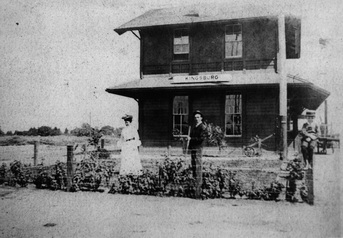
Kingsburg Depot sometime after 1902. This is Kingsburg's third depot, the SP Common Standard No. 18 style depot built in Monson in 1888 and moved to Kingsburg, and the heart of the Depot we know today. , a Common Standard No. 18 style, photo. This is the original 1875 Central Pacific 32 x 110 foot depot. It was a deluxe affair for a rural site with few residents. It had freight and passenger accommodations on the first floor, and living space for the station agent and his family on the second floor. Notice there are no other buildings in this view of Kingsburg looking south-southeast. Kingsburg is a railroad town, and the depot is the seed from which it grew. The tree line in the distance is the Kings River. The Depot water system was a wind-driven pump and elevated tank on the north side of Main (now Draper) Street. In this photo the station agent and his family are tending their garden along Main Street. The little boy seated on the post is no doubt waiting for the next train to appear.
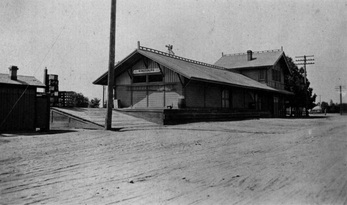
1903 photo. This is the 1888 Monson Depot after it was moved to Kingsburg, viewed from the intersection of Lewis and California streets. The ancestors of many Kingsburg residents entered the City through the doors of this depot. Note the dirt street - there was no paving until the 1920's. Also note the outhouse at left, and the ramp onto the freight dock. Monson is 15 miles east of Kingsburg in Tulare County. The Monson Depot was built on the SP Exeter Branch and was never opened due to a lack of business. The Exeter Branch left the mainline in Fresno and reconnected with the mainline at Famoso Junction north of Bakersfield. This ex-SP loop is now operated by the San Joaquin Valley Railroad.
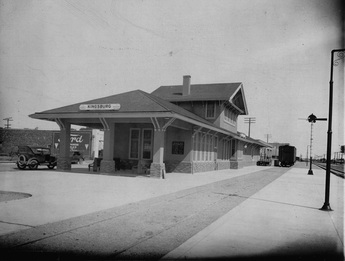
1923, Ray Olson collection. This is the Kingsburg Depot after it had been updated by SP in 1923. In 1922 the Depot was damaged by fire, but was saved, updated and reopened in October 1923. SP records indicate it was a new depot, but it was actually the old one that had been extensively updated. It was moved south a short distance to keep northbound passenger trains from blocking the main street when they stopped to pick up passengers. 1923 additions included a covered patio, smoking and non-smoking waiting rooms, electricity, indoor plumbing, restrooms, a plaster interior in the Waiting Room and Office areas with varnished pine trim and wainscoting, and a stucco exterior with waterfall brick wainscoting. Note the Model T Ford parked at the Depot and the Ford automobile dealership in the background. There is extensive paving in the track area to accommodate passengers, and a semaphore signal that signaled trains to stop or pass. The signal was controlled by levers on the telegraph table inside the office. These levers were connected to the signal by means of control rods buried in pipes underground. The track through Kingsburg runs north and south, but on the SP system trains headed towards San Francisco were called westbound, and trains headed toward New Orleans were called eastbound. The Station Agent used these levers to set the signal at stop or pass positions to signal trains coming from either direction. In this photo the semaphore signal is set in the "stop" position, so there are passengers waiting to board the next train.
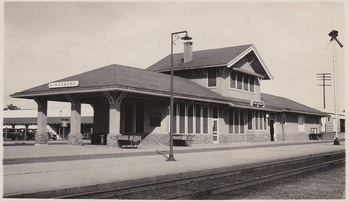
1940, Ray Olson collection. A few changes can be seen from the 1923 photo. The semaphore signal is set in the "pass" position. The Ford dealership in the background has added a covered car area with trade-ins, and there are more freight and baggage carts parked around the Depot. Passenger and freight traffic were growing heavier in 1940 as the nation recovered from the Great Depression and lend-lease manufacturing began to supply Britain with military equipment. Many young men got on a train in Kingsburg headed for jobs in the shipyards of San Diego or the aircraft plants of Los Angeles. Even though the United States was still a neutral party in 1940, American military forces were building for a conflict the nation hoped would not come. December 7th 1941 ended that hope with the Japanese attack on the Pearl Harbor Naval Base in Hawaii. Soon a flood of young Americans were leaving to join the military. The bodies of some would later return by train in military coffins, casualties of war coming home for burial in the Kingsburg Cemetery.
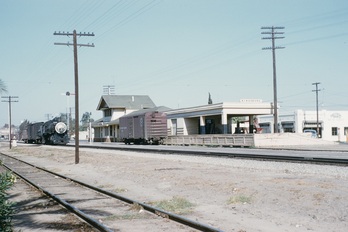
1955, Lennis Scheline photo. This shows the Depot from a perspective looking north across the tracks from the old Highway 99 northbound lanes near Aslan Packing (now Simpson Street). The freight dock has been covered with flat tar paper roof. Steam engine X2335 is on the mainline, X marking it as an extra, a train not regularly scheduled. Note the west siding along the the mainline where no track exists today. Nearly all businesses were served by rail before commercial trucking began growing in the 1950's. State Highway 99 we know today was not built until 1965, and there were no elevated grades or overpasses dividing Kingsburg. City streets and train tracks crossed the old highway at grade. Businesses east of the tracks were served by the east siding that is still in service. Businesses on the west side were served by the west siding seen here. There were several spurs off this siding that crossed the northbound lanes of the old highway (now Simpson Street). If you look carefully along the west side of Simpson between Kadys Kitchen and Sierra Street, you can still see sections of jointed rail that are remnants of a spur that served Smith's Tire Company (now Kadys Kitchen) and Fred's Truck Stop (now a vacant lot). These are last remains of the west siding and spurs.
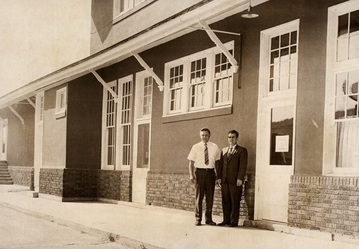
1968, Kingsburg Chamber of Commerce photo. When SP ended passenger service in 1968 they closed the depot office and the last station agent moved out. Some time later the waiting room was leased by the Chamber of Commerce and used as their office. The Historical Society occupied the rest of the Depot and turned it into a museum. With the help of service organizations and other volunteers the exterior was painted red with white trim, and a large orange Dala Horse statue was placed on the roof. The Dala Horse is a stylized depiction of a horse popular in Scandinavian culture. (96% of the population in Kingsburg was once Swedish immigrants). The two men in the photo are Lowell Carlson (left) and Jack Creighton (right), directors of the Chamber. The large Dala Horse statue was created by art students at the High School, and was installed on the second-story roof by T.C. Moshier and friends. T.C. told this writer it was windy the day they winched the Horse onto the roof, and they nearly lost control before getting it secured. The big orange Horse was lit up at night, and made quite a spectacle for drivers passing by on the Highway. It became famous one night when Johnny Cash was passing through the Valley. When he saw the horse he had his driver pull off the highway and come into town so he could check it out. The Man in Black knew something spectacular when he saw it. In the late 1970's the Historical Society moved to their new home at Historical Park. In 1987 the Chamber moved to a new Welcome Center. The horse disappeared, and the Depot sat empty for the first time in 112 years.

1996, Larry Esau photo. At the time of this photo the Depot had been empty 9 years and had not been maintained by SP for more than 28 years. It was so badly deteriorated that sections of the roof had fallen away and most windows were broken. Many in the city thought the building should be torn down. In the 1980's SP began bulldozing old depots, and the future looked grim. Foreseeing that threat, Steve Britton and Larry Esau asked the City Council to apply for County and State historic status for the building in 1984. Fresno County quickly awarded that status, and the State followed in 1987. When an SP wrecking crew came into town to knock the building down in 1988, City Manager Robert Kelly showed them the historic status documents, and the imminent crisis was averted. But SP steadfastly refused to let anyone maintain the building, and it became clear they would let it fall down if they couldn't knock it down. Citizens working with the City tried everything possible to obtain ownership of the Depot, but the railroad would only let it go if it was moved from the site. Moving it would have destroyed its historic value and left an empty lot in the heart of downtown. Those that cared about the Depot agonized as the building fell further and further into disrepair.
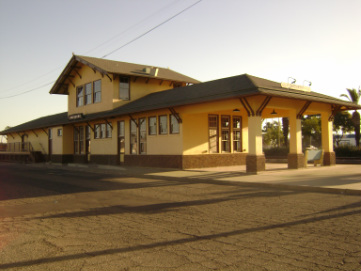
2015, Larry Esau photo. In 1996 Union Pacific bought the Southern Pacific Railroad and a ray of hope appeared. Union Pacific takes pride in the history of American railroading. Mayor John Wright met with UP officials, and they agreed to transfer ownership of the Depot to the City. It was a long process, but thanks to Wright's persistence the City finally gained title to the Depot in 2005. Meanwhile a Depot Planning Committee of seven citizens had been appointed by the City Council to determine the best use of the building if it could be restored. An educational use quickly rose to the top of the list. The City had no money to restore the building, so members of the Depot Planning Committee decided to incorporate as a non-profit entity to raise money for a rehabilitation. Friends of the Historic Kingsburg Depot was born on November 17, 2005, and volunteers began cleaning up the site. In 2006 IRS tax-deductible status was granted and the Friends Capital Campaign began, and by 2015 nearly $640,000 in donations of cash and in-kind building materials had been received, and Friends volunteers had worked over 16,000 hours at the site. With the addition of a federal grant in 2012 sufficient funds were available to move the rehabilitation along to near completion. This work was completed by General Contractor C.J. Brock in October 2015. In November Friends volunteers once again began work to complete two areas not covered by the grant: the Freight House and second-story Apartment.